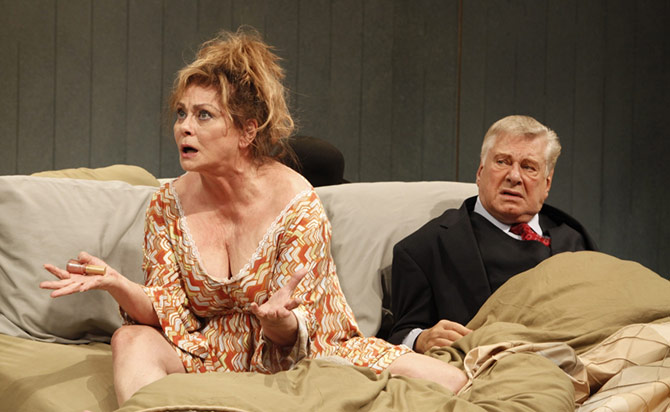A New Albee
by Anthony Chase

Edward Albee’s recent visit to Buffalo to take in the Road Less Traveled production of his play, The Goat or, Who is Sylvia?, puts him squarely in the center of our city’s theatrical consciousness. Right now, his newest play, Me, Myself & I, is having its New York debut at Playwrights Horizons. The piece was first produced a couple of seasons ago, at the McCarter in New Jersey. Emily Mann, artistic director at the McCarter, has directed both productions. For New York, Elizabeth Ashley has replaced Tyne Daly, who was highly praised in the original. Brian Murray returns to play her live-in doctor.
The situation is this: Mother, played by Ashley, was abandoned by her husband, 28 years ago, when she gave birth to identical twin sons. Though the boys are now 28 years old, she cannot tell them apart. Adding to the dilemma, she has given them the similar palindromic names OTTO and otto. When the husband departed, Mother’s doctor moved in. We see them in bed—Mother in a negligee; doctor in a suit and tie. It is a peculiar relationship.
Unlike Mother, the audience can easily distinguish between the twins, for OTTO has an unmistakable sadistic streak. As the play begins, evil OTTO announces that he is leaving home to become Chinese and that his twin brother does not exist. He concedes that he has a twin, but no brother. Needless to say, this upsets kinder and gentler otto. Unable to tell which son is being so foul to her, Mother is whipped into a state of dishevelment. (Elizabeth Ashley looks smashing in such a state, by the way.)
From this starting point, Albee embarks on a whirlwind of word play and breathless existential theatrics.
The interchangeability of identical twins is an old premise. Plautus had a go with it, back in the days of Rome. Shakespeare reworked it. Even Rodgers and Hart took their stab with George Abbott’s revision. Now Albee has his absurdist go.
Those who saw the original production of the play report that they are disappointed by its current incarnation. I have only this version to go on, and so, while I found the material to be meandering and repetitive (something the breakneck pace of the original seems to have rendered unimportant), I did experience the thrill of a new Albee play enfolding before me.
While the play is adventurous, a familiar quality does hover over the material. Here we have the hallmark Albee theatricality and philosophical playfulness. We have a new monstrous Albee mother. We have a situation that sends us off into puzzles that collapse into puzzles in seemingly endless fun and confusion. Among the most outrageous flourishes is Mother making mincemeat of otto’s girlfriend with an onslaught of racist invective.
Among Albee’s variations on the comedy of errors premise is his folding in of the equally popular device of the evil twin. For instance, OTTO’s denial of his brother does not stop him from adopting otto’s identity so that he can enjoy the good brother’s girlfriend. And this metaphor for collapsing identities folds further into acrobatic word play, and issues of words not expressing what people really mean.
The production is exquisitely designed by Thomas Lynch, a blank expanse onto which Albee inscribes his story.
Descriptions of the play, as performed in New Jersey, suggest a much more substantial evening than the one I witnessed. To my recent observation, Me, Myself & I adds up to a minor work in a canon that astonishingly includes Who’s Afraid of Virginia Woolf, A Delicate Balance, and Three Tall Women. Still, Albee devotees will find plenty to engage them, and there is abundant fodder for essays yet to be written on our nation’s most highly regarded living playwright.
|
Issue Navigation> Issue Index > v9n38 (Fall Food Issue, week of Thursday, September 23) > Theater Week > A New Albee This Week's Issue • Artvoice Daily • Artvoice TV • Events Calendar • Classifieds |









 Current Issue
Current Issue